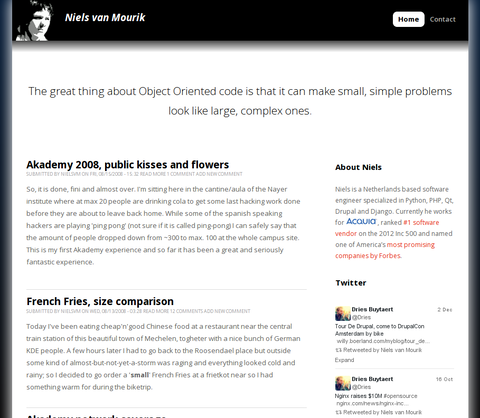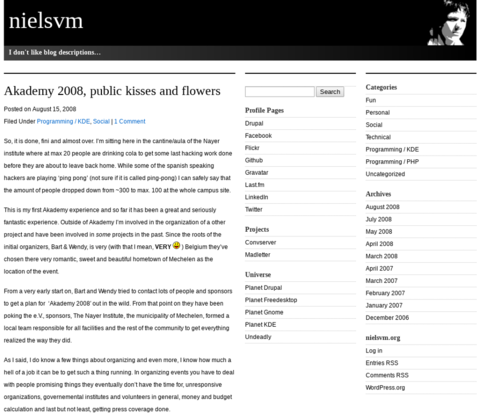This very website you are looking at is as much an example of my work as all the others, and perhaps the best example. My original site was made in Wordpress in October 2007 and - although blog content stalled for a long time - was technically maintained over time. As I grew more and more familiar with Drupal because of my work, and because Wordpress was increasing my worries about security... I decided to throw it out.
Throughout 2012 I've migrated the website over to Drupal and wrote scripts that
automatically pulled the old content out of Wordpress using XML-RPC and into
Drupal. The porting highlighted interesting issues such as rewriting rotten HTML
generated by Wordpress'es WYSIWYG editor and (re)attaching files, tags and
other metadata such as categories and publication dates. With a responsive
design the Drupal site was viewable on about every device and looked good under
all conditions. I applied Drupalisms such as features,
views and several more.
Fast-forward to 2016, I still barely wrote anything for my Drupal based blog, this frustrated me a bit. What frustrated me more was the maintenance work I regularly had to do for Drupal's many modules and core, continuously exposing the site to serious security risks and taking away precious free time. Despite my love, familiarity and logical choices for Drupal, I had thought about changing it again...
I rebuilt the entire site as a static HTML website using the lektor Framework,
which is a Python based application which let me write all content in
Markdown. This - once again - required
me to write migration scripts to preserve content that was about 10 years old.
Apart from that, I decided to merge content from my kdetipsdb.nielsvm.org
website, which was built in Drupal 8 and heavily exposed to even more security
bugs. Both migration scripts generated .md files, transformed all the Drupal
fields into Lektor fields and attached all static files. Apart from a few simple
hand-fixes, the content came over perfectly and generating HMTL out of Markdown,
is a far better and cleaner idea than writing HTML.
The current website is as fast as it gets, has no PHP and allowed me to peek
inside other kitchen's than Drupal. I learned a few side-techniques such as
SASS and applied quite some HTML5 and CSS3 idioms.


